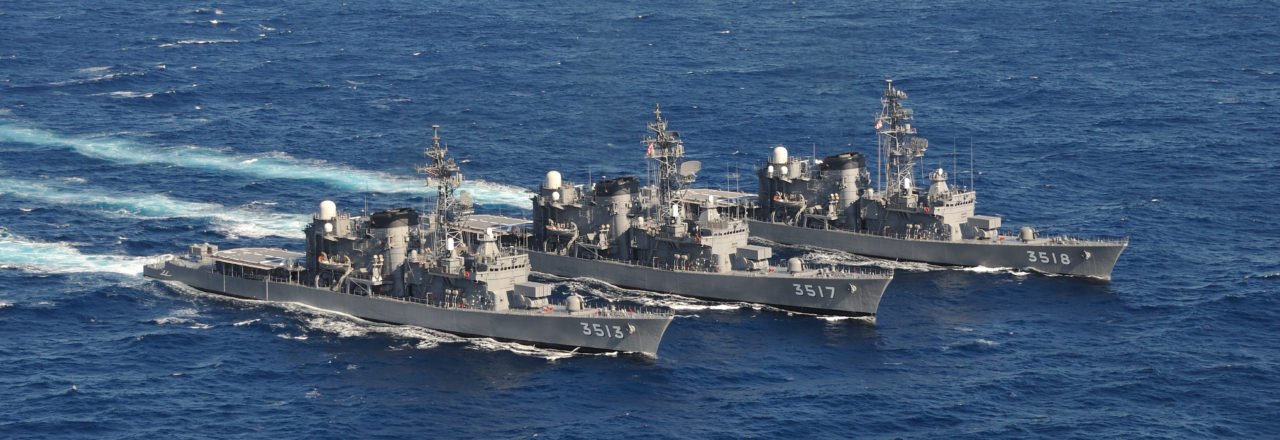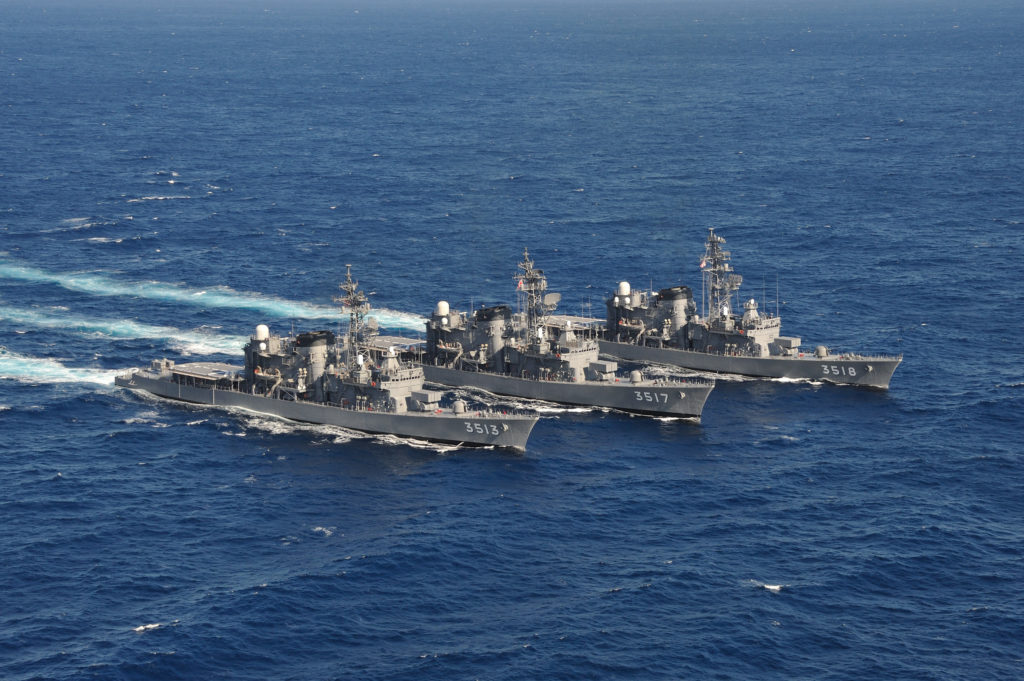
Japan’s Maritime Self-Defense Force (MSDF), as it is officially known, is one of the world’s most powerful navies. Its fleet is larger than those of traditional European powers like France and the United Kingdom combined. But over the last decade, the MSDF has seen its position eclipsed by that of China’s navy, which has grown to twice its strength in terms of submarines and oceangoing surface combatants, like destroyers and frigates. More worrisome still for Tokyo, China has added a host of warships with entirely new capabilities, including aircraft carriers that can launch fixed-wing aircraft and an array of amphibious vessels. By comparison, the MSDF has seemed trapped in time. Its force structure and personnel strength, until recently, have been nearly identical to what they were two decades ago.
But for all the stillness above the waterline, there has been stirring below it. For most of the 2010s, Tokyo has worked to lay the groundwork for the revitalization of its navy, a key component of its “dynamic defense” strategy. Although that may immediately bring to mind then-Japanese Prime Minister Abe Shinzō’s efforts to change Japan’s pacifist constitution, his government’s efforts to improve Japan’s defense procurement process and defense industry’s competitiveness were also vitally important. With those efforts set into motion, Tokyo could set about transforming the MSDF from a force narrowly focused on defending Japan’s home islands and performing escort duties into a more balanced one with the amphibious and power-projection capabilities needed to protect its remote territories. So far, Japan has managed that naval transformation on a shoestring. But if further progress is to be made, the MSDF will require not only more funding, but also more personnel.
Go South, Young Sailor
Throughout the Cold War, the MSDF’s strategic orientation was directed to the north and west, towards the Soviet Union. The MSDF’s missions were to defend Japan’s home islands from the Soviet Pacific Fleet and help the U.S. Navy protect the sea lanes of communication across the Pacific Ocean. Naturally, those missions put a premium on anti-air and anti-submarine warfare capabilities. That focus was reinforced during the first couple of decades after the Cold War. North Korea’s ballistic missile and nuclear weapons programs led Japan to build the world’s second largest fleet of Aegis-equipped warships, whose powerful SPY-1D air-search radars can function as part of an anti-ballistic missile defense network. They also kept the MSDF oriented in the same general direction.But the first inklings of change were already in the making. In 2001, a Chinese navy surveillance ship circumnavigated Japan for the first time.[1] While top Japanese leaders worried at the time whether it was a portent of the future, they did little in response. They were more concerned about wringing more efficiency out of the navy. By 2004, they trimmed the size of the MSDF’s fleet and consolidated its command structure. But a few years later, rising Chinese assertiveness over the Senkaku Islands (Diaoyu in China) in the East China Sea and the rapid growth in Chinese naval capabilities finally convinced Tokyo to reorient the MSDF southward.
The shift was also reflected in Japan’s national policy. Over the course of the next decade, Tokyo became ever more concerned about its southern maritime border. The level of that concern could even be quantified in Japan’s National Defense Program Guidelines (NDPG), which outlines the country’s security plans every five years. Between the 2013 and 2018 editions of the NDPG, the number of references to China doubled. In a decided departure from earlier iterations, the 2018 NPDG openly called Beijing’s “unilateral, coercive attempts to alter the status quo” as “incompatible with the existing international order.”[2] Though perhaps not fighting words, they were, for a normally diplomatic Japan, remarkable.
Towards a Balanced Fleet
By the early 2010s, China had begun to routinely send its coast guard vessels well within 12 nautical miles of the Senkaku Islands and its navy warships through the straits between Japan’s islands in the Ryukyu archipelago. Given the growing possibility that China could seize one of the Senkaku Islands, Tokyo decided that it needed an amphibious landing capability to either defend or retake the islands. Such a capability would serve as a deterrent to China. And so, in 2013, Japan began to raise a new 3,000-man amphibious rapid deployment brigade. By the end of the decade, Japan would also acquire two helicopter carriers, 52 amphibious assault vehicles, and the first of 17 American V-22 transport aircraft for fast insertion.Of course, amphibious forces require air support if they are to succeed. While Japan’s air base on Okinawa would be the most likely source of that support, it is almost 400 km from the Senkaku Islands and could easily be targeted by Chinese ballistic missiles. Aircraft carriers are an obvious solution. Hence, it was not entirely surprising that the design of the MSDF’s two new Izumo-class helicopter carriers resembled that of an aircraft carrier. Likely, even before the keel of JS Izumo was laid down in January 2012, Japanese naval planners had wanted the option to convert it and its sister ship into fully fledged aircraft carriers in the future.
Perhaps not so coincidentally, only a month earlier, Japan chose the American F-35 as its next generation multirole fighter. Doing so gave it the option to procure the fighter’s F-35B variant, which is capable of short takeoffs and vertical landings on aircraft carriers, without the need for substantially more aircraft maintenance and pilot training infrastructure. A little over six years later, Tokyo exercised both options. In 2018, Japan revealed that it would convert its two Izumo-class helicopter carriers into light aircraft carriers and buy 42 F-35B fighters for carrier duty. Given the number of fighters it ordered and the likely aircraft capacity of its Izumo-class aircraft carriers, Japan would have enough fighters for one or two more small aircraft carriers. Those carriers could prove useful for an expedition near the East China Sea.
But if such an expedition were necessary, the MSDF would have to be prepared to encounter the full might of China’s navy, including its submarines. Given that potential, Japan has also begun to increase the size of the MSDF’s submarine fleet. The 2018 NDPG called for a fleet of 22 boats by 2023, an increase of three over the current order of battle. The latest of these is the JS Taigei, launched in October 2020. It is the lead boat for the Taigei class of diesel-electric attack submarines, which features not only air-independent propulsion, but also lithium-ion batteries. Air-independent propulsion allows submarines to extend their underwater endurance from a few days to almost two weeks. Meanwhile, lithium-ion batteries will enable them to stay submerged even longer and cruise at higher speeds. Such capabilities, along with new acoustic absorbent construction and materials, will likely make the JS Taigei the world’s stealthiest diesel-electric attack submarine, when it is commissioned.
Over time, new Taigei-class submarines will replace the MSDF’s older Oyashio-class diesel-electric attack submarines. But even the oldest Oyashio-class submarine (which was converted into a training boat) is barely 20 years old and still highly capable. In many respects, Oyashio-class submarines are more modern than the Kilo-class or Song-class diesel-electric attack submarines in China’s navy. In fact, Japan has had a long history of replacing naval warships long before they are obsolete. That rapid retirement cycle gives Japan the flexibility to quickly enlarge its fleet by simply reducing the rate at which it retires older warships.
However large the MSDF becomes, it must ultimately be ready for battle. That requires frequent training and exercises, which the MSDF has stepped up even in the distant waters of the South China Sea and the Indian Ocean. Of course, a force’s readiness is hard to measure. But the Tōhoku earthquake and tsunami that struck Japan in 2011 offered a glimpse of what the MSDF’s readiness might be. Within 24 hours of the event, the MSDF had put its entire fleet under a single commander and sortied over a third of its surface combatants. While not all of the ships were fully manned, the fact that they could be loaded with relief supplies and get underway so quickly was an impressive feat for any navy.
Scaling with Economy
Maintaining a high state of readiness with limited resources is not an uncommon problem. Indeed, the MSDF has dealt with it better than most navies. But more needs to be done, if it is to fully execute Japan’s “dynamic defense” strategy, which emphasizes the conduct of timely and tailored operations rather than force levels. To carry out such operations, the MSDF will have to work ever more closely with Japan’s air force, otherwise known as the Air Self-Defense Force (ASDF). The MSDF will have to rely on the ASDF for not only air cover and air support, but also persistent intelligence, surveillance, and reconnaissance from its airborne early-warning aircraft and ground-based early-warning radars. The need to conduct such joint operations was noted in the 2013 NDPG and further stressed in the 2018 NDPG.[3]Responding faster is one thing, responding on even terms is another. With China building increasingly powerful warships, like its 13,000-tonne Type 055 destroyers, the MSDF will eventually need ships and submarines with larger magazines and longer ranges (as well as additional replenishment ships to keep them supplied at sea). But at this time, Tokyo has not made such vessels a priority. Japan currently envisions a total tonnage of 66,000 tons for the ships it will acquire through 2023. Considering that its five planned Taigei-class submarines alone constitute 15,000 tonnes, that leaves only 51,000 tons for the remaining ten destroyers, four patrol vessels, and four “other ships” in its plan, hardly enough for bigger warships.[4]
Nevertheless, the MSDF’s most pressing need is personnel. While Tokyo plans to modestly expand the size of the MSDF’s fleet, it has revealed no corresponding plan to increase the number of its personnel. Already, Japan’s navy operates more leanly than many others. The MSDF, with 45,400 personnel, has a ratio of 680 personnel to each of its warships.[5] That compares to ratios of over 1,000 for the navies of France and the United Kingdom. While eking out greater efficiency from any organization is admirable, the MSDF will eventually reach a point where it can no longer do so without meaningful tradeoffs. More personnel on sea duty means fewer ashore personnel who are devoted to maintenance, refit, and supply roles. But performing those roles well remains critical, especially if the MSDF is to maintain a high state of readiness during prolonged crises.
Japan has answered the question of whether it is willing to overcome its past inertia to prepare for a more dangerous future. Its navy’s quiet renaissance over the last decade has been proof of that. But the bigger question is whether that will be enough should push come to shove in the Western Pacific.
The views expressed in this article are those of the authors alone and do not necessarily reflect the position of the Foreign Policy Research Institute, a non-partisan organization that seeks to publish well-argued, policy-oriented articles on American foreign policy and national security priorities.

Born Again: Japan’s Maritime Self-Defense Force Revitalization - Foreign Policy Research Institute
Japan’s Maritime Self-Defense Force (MSDF), as it is officially known, is one of the world’s most powerful navies. Its fleet is larger than those of traditional European powers like France and the United Kingdom combined. But over the last decade, the MSDF has seen its position eclipsed by that...


